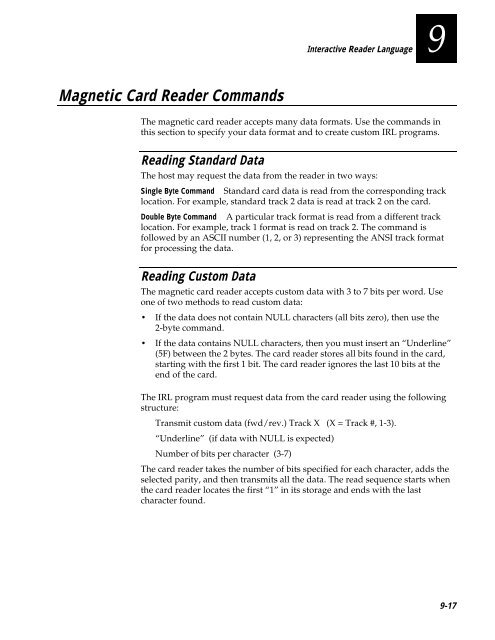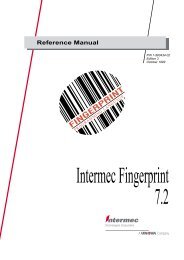- Page 1 and 2:
nugget code39 helconital User’s M
- Page 3:
nugget code39 helconital Manual Cha
- Page 6 and 7:
9560 Transaction Manager User’s M
- Page 8 and 9:
9560 Transaction Manager User’s M
- Page 10 and 11:
9560 Transaction Manager User’s M
- Page 12 and 13:
9560 Transaction Manager User’s M
- Page 15 and 16:
Before You Begin nugget code39 helc
- Page 17 and 18:
nugget code39 helconital fBefore Yo
- Page 19 and 20:
This Convention Means nugget code39
- Page 21 and 22:
nugget code39 helconital A B C D E
- Page 23 and 24:
Roadmap For Help With Start Here nu
- Page 25 and 26:
nugget code39 helconital Getting St
- Page 27:
nugget code39 helconital Getting St
- Page 30 and 31:
nugget code39 helconital
- Page 32 and 33:
9560 Transaction Manager User’s M
- Page 34 and 35:
9560 Transaction Manager User’s M
- Page 36 and 37:
9560 Transaction Manager User’s M
- Page 38 and 39:
9560 Transaction Manager User’s M
- Page 40 and 41:
9560 Transaction Manager User’s M
- Page 42 and 43:
9560 Transaction Manager User’s M
- Page 44 and 45:
9560 Transaction Manager User’s M
- Page 46 and 47:
9560 Transaction Manager User’s M
- Page 48 and 49:
nugget code39 helconital
- Page 50 and 51:
9560 Transaction Manager User’s M
- Page 52 and 53:
9560 Transaction Manager User’s M
- Page 54 and 55:
9560 Transaction Manager User’s M
- Page 56 and 57:
9560 Transaction Manager User’s M
- Page 58 and 59:
9560 Transaction Manager User’s M
- Page 60 and 61:
9560 Transaction Manager User’s M
- Page 63 and 64:
nugget code39 helconital A B C D E
- Page 65 and 66:
Starting the 9560 Operating the 956
- Page 67 and 68:
Reading Bar Code Labels Operating t
- Page 69 and 70:
Using the Magnetic Card Reader Oper
- Page 71 and 72:
Operating the 9560 4 4. Practice us
- Page 73 and 74:
Using the Keypad The 9560 has three
- Page 75 and 76:
nugget code39 helconital A B C D E
- Page 77 and 78:
Data Communications and Operating O
- Page 79 and 80:
Data Communications and Operating O
- Page 81 and 82:
Data Communications and Operating O
- Page 83 and 84:
Data Communications and Operating O
- Page 85 and 86:
Data Communications and Operating O
- Page 87 and 88:
Data Communications and Operating O
- Page 89 and 90:
Data Communications and Operating O
- Page 91 and 92:
Data Communications and Operating O
- Page 93 and 94:
Data Communications and Operating O
- Page 95 and 96:
ASCII Chart Data Communications and
- Page 97 and 98:
ASCII Control Characters Data Commu
- Page 99 and 100:
Entering Katakana Characters Data C
- Page 101 and 102:
Katakana Characters in Roman Alphab
- Page 103 and 104:
Special Katakana Characters in Japa
- Page 105 and 106:
Data Communications and Operating O
- Page 107 and 108:
nugget code39 helconital A B C D E
- Page 109 and 110:
Configuring the 9560 This chapter e
- Page 111 and 112:
Operating Parameters Configuration
- Page 113 and 114:
Communications Protocol Configurati
- Page 115 and 116:
Configuring the 9560 User-Defined a
- Page 117 and 118:
Downloading Configuration Commands
- Page 119 and 120:
Configuring the 9560 6 Moving Aroun
- Page 121 and 122:
SELECT CODES NO 3. Press Space. The
- Page 123 and 124:
Configuration Prompts for 2x40 Stan
- Page 125 and 126:
Configuration Prompts for 2x40 Stan
- Page 127 and 128:
Configuration Prompts for 1x20 Disp
- Page 129 and 130:
Configuration Prompts for 1x20 Disp
- Page 131:
Configuration Prompts for 1x20 Disp
- Page 135 and 136:
Configuration Commands This chapter
- Page 137 and 138:
AFF (Affirmative Acknowledgment) Co
- Page 139 and 140:
Baud Rate Configuration Commands -
- Page 141 and 142:
Character Set Configuration Command
- Page 143 and 144:
Or: To use Codabar Standard, scan o
- Page 145 and 146:
Code 39 Configuration Commands - Co
- Page 147 and 148:
Code 128 Configuration Commands - C
- Page 149 and 150:
Data Bits Configuration Commands -
- Page 151 and 152:
EOM (End of Message) Configuration
- Page 153 and 154:
Intercharacter Delay Configuration
- Page 155 and 156:
Interleaved 2 of 5 (I 2 of 5) Confi
- Page 157 and 158:
IRL END (End of Program) Configurat
- Page 159 and 160:
IRL EOP (End of Program Block) Conf
- Page 161 and 162:
IRL PAK (Program Acknowledge) Confi
- Page 163 and 164:
IRL RUN Configuration Commands - IR
- Page 165 and 166:
Katakana Configuration Commands - K
- Page 167 and 168:
Configuration Commands - Katakana K
- Page 169 and 170:
NEG (Negative Acknowledgment) Confi
- Page 171 and 172:
POL (Poll) Purpose: Solicits or req
- Page 173 and 174:
Protocol Configuration Commands - P
- Page 175 and 176:
REQ (Request for Acknowledgment) Co
- Page 177 and 178:
Resume IRL Configuration Commands -
- Page 179 and 180:
Scanner Operation Configuration Com
- Page 181 and 182:
Select Terminal Mode Configuration
- Page 183 and 184:
Stop Bits Purpose: Sets the number
- Page 185 and 186:
Time in Seconds Purpose: Determines
- Page 187 and 188:
Turnaround Delay Configuration Comm
- Page 189 and 190:
UPC/EAN Configuration Commands - UP
- Page 191 and 192: 6. Scan this label: Exit Configurat
- Page 193: XON Configuration Commands - XON Pu
- Page 196 and 197: nugget code39 helconital
- Page 198 and 199: 9560 Transaction Manager User’s M
- Page 200 and 201: Data Entry Commands - Clear Clear P
- Page 202 and 203: Data Entry Commands - Default Confi
- Page 204 and 205: Data Entry Commands - Enable Clock
- Page 206 and 207: Data Entry Commands - Enter Compute
- Page 208 and 209: Data Entry Commands - Enter IRL Edi
- Page 210 and 211: Data Entry Commands - Exit Auto-Tri
- Page 212 and 213: Data Entry Commands - Exit Full ASC
- Page 214 and 215: Data Entry Commands - High Beep Hig
- Page 216 and 217: Data Entry Commands - LED/Relay Con
- Page 218 and 219: Data Entry Commands - Low Beep Low
- Page 220 and 221: Data Entry Commands - Preamble B Pr
- Page 222 and 223: Data Entry Commands - Reset Reset P
- Page 224 and 225: Data Entry Commands - Run Program R
- Page 227 and 228: nugget code39 helconital A B C D E
- Page 229 and 230: Introduction to IRL Interactive Rea
- Page 231 and 232: Exiting from Command Line Mode Inte
- Page 233 and 234: Interactive Reader Language To exit
- Page 235 and 236: Unique IRL Commands for the 9560 In
- Page 237 and 238: Interactive Reader Language W2 :Lea
- Page 239 and 240: Interactive Reader Language G#0=0.S
- Page 241: Program Listing #3 Controlling the
- Page 245: Card Reader Responses to Host Comma
- Page 248 and 249: nugget code39 helconital
- Page 250 and 251: 9560 Transaction Manager User’s M
- Page 252 and 253: 9560 Transaction Manager User’s M
- Page 255 and 256: nugget code39 helconital A B C D E
- Page 257 and 258: Specifications A This appendix list
- Page 259 and 260: Hardware Interfaces Port Interface
- Page 261: Input Devices Compatible With the 9
- Page 265 and 266: ASCII Bar Code Labels Full ASCII Ch
- Page 267 and 268: Symbols ! * /A* * /A* , (comma) * /
- Page 269 and 270: Uppercase Letters A * A* * A* B * B
- Page 271: A B C D E Caps F G H I J $ K L M N
- Page 274 and 275: 9560 Transaction Manager User’s M
- Page 276 and 277: 9560 Transaction Manager User’s M
- Page 279: A B C D E Caps F G H I J $ K L M N
- Page 282 and 283: 9560 Transaction Manager User’s M
- Page 284 and 285: 9560 Transaction Manager User’s M
- Page 286 and 287: 9560 Transaction Manager User’s M
- Page 288 and 289: 9560 Transaction Manager User’s M
- Page 290 and 291: 9560 Transaction Manager User’s M
- Page 292 and 293:
9560 Transaction Manager User’s M
- Page 294 and 295:
9560 Transaction Manager User’s M
- Page 296 and 297:
9560 Transaction Manager User’s M
- Page 299 and 300:
Index Numbers 1700 keyboard, 1-6, 6
- Page 301 and 302:
command, data entry continued Enter
- Page 303 and 304:
G getting started, 1-3 glossary, G-
- Page 305 and 306:
output relays, continued descriptio
- Page 307:
Transmit File command, 8-31 Transmi
















